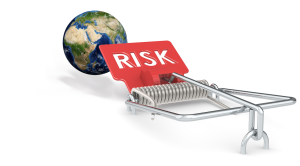Unleashing 3 Risk Arguments in the Climate Debate
Any good business case for doing something new or different has two components: opportunity and risk. Governments, companies, communities, and people like you and me need to justify why we change: what’s the upside if we do (opportunity), and what’s the downside if we don’t (risk). When it comes to convincing companies to be more sustainable, we’ve done a good job on the opportunity side. We need to be smarter on the risk side. Below are 3 risk arguments in the climate debate.
For twelve years, my focus has been on helping companies to size the benefits (opportunity) of sustainability-oriented strategies. Any company can use the free dashboard and spreadsheets on my website to size its potential bottom-line benefits from aggressive sustainability-related strategies. They will find that if a typical company were to use best-practice sustainability approaches already being used by real companies, it could improve its profit by at least 51 to 81 percent within three to five years. The opportunity side of the business case is robust.
However, I low-balled the risk side. The business case simulator evaluates 14 sustainability-related risks that could hit a company in the next three to five years, and shows that they could jeopardize 16 to 36 percent of today’s profits if the company did nothing more on sustainability than it is already doing. On the climate change front, the simulator assesses the cost to a company if governments were to put a price on carbon in an effort to mitigate climate change. However, my methodology doesn’t size the cost of a 15th risk—the risk to company operations if / when climate destabilization happens.
I omitted that risk because I thought at the time that it was beyond the three-to-five year range used throughout the business case simulator. However, as pointed out in my January 7 blog, extreme and weird weather associated with climate destabilization is already happening. If we factor in the potential direct and indirect costs of climate change on a company and its value chain, the risk to profits would be much higher than 16 to 36 percent. In fact, all bets might be off on the company continuing as a going concern. So this would help size the company-level climate risk? the potential cost to a company if it did not do more to help mitigate climate change. Maybe alerting companies to this risk would energize them to reduce their carbon footprints and to lobby governments to institute more aggressive policies to avoid climate destabilization.
There is also a society-level climate risk—the cost to society if it does not do more to avoid climate change. This is the argument we should lead with to get the attention of citizens, businesses, and governments. Climate scientists and economists are becoming more forceful in their sizing of the potential economic, social, and ecological costs / risks of climate destabilization. This energizes people concerned about the world that their kids and grandchildren are inheriting.
There is a third risk-related argument in the climate destabilization debate: the relative risk argument. The most effective articulation of this risk argument that I have seen is in a ten minute video posted on YouTube by science teacher Greg Craven in 2007: “The Most Terrifying Video You’ll Ever See 2.”
It is a corny and obviously low budget production. Maybe that’s why it is so memorable. What it lacks in production value, it makes up for with logic. Its case for action is compelling because it is based on relative risk, not opportunity. Greg barely talks about how great it will be if we avoid climate destabilization—the upside. Instead, he deploys a relative risk argument on the downside.
He uses a simple 2 x 2 risk analysis matrix to show that the risk of not acting to prevent climate destabilization is greater than the risk of taking action for nothing. He compares the risk of not stopping climate destabilization—the downside—to the risk of wasting money trying to prevent something that might not happen (despite climate scientists’ ominous predictions). The video mentions absolute risks but focuses on relative risks. The risk / cost of inaction on climate change if it does happen far outweighs the risk / cost of wasted action if it doesn’t happen. The relative risk case is the clincher. Very clever.
From my experience, risk-avoidance is a more powerful driver of change that opportunity-capture. Risk provides the wake-up call; opportunity is the icing on the cake. It’s time we unleashed our company-level, society-level, and relative risk arguments in the debate about climate destabilization. If we care about our children and grandchildren, this is a debate that we can’t afford to lose.
Please feel free to add your comments and questions using the Comment link below. For email subscribers, please click here to visit my site and provide feedback.
Bob





Comments are closed.